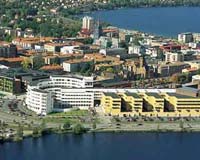| . |  |
. |
Singapore (AFP) Aug 18, 2009 Asia is outpacing the United States and Europe in the rebound from the global economic slump, thanks to multi-billion dollar stimulus packages and robust demand from China, analysts said. Second-quarter indicators showed the region's recession-hit economies such as Singapore and Hong Kong have returned to the growth path despite sluggish demand from the US and European markets, their main export destinations. Countries with bigger domestic populations, including China, India, Indonesia, South Korea, the Philippines and Vietnam, have been growing during the global downturn although the pace has slowed. Japan, the world's second largest economy, lumbered out of recession in the second quarter and Prime Minister Taro Aso credited the government's stimulus package for the achievement. In contrast, US gross domestic product was estimated to have shrunk 1.0 percent in the second quarter, and the eurozone economy dipped a milder than expected 0.1 percent after Germany and France emerged from recession. US-based credit ratings firm Standard and Poor's said that five of the 14 Asia-Pacific economies it covers will post positive growth this year, with nine expected to report contractions. But by next year, all 14 should post year-on-year growth, led by China's projected expansion of 8.0-8.5 percent. The US economy is forecast to contract by 2.9 percent this year and grow 1.5 percent in 2010, it added. Asian economies were hammered after a crisis in the US housing market sparked global financial and economic turmoil late last year. Some analysts said the impact on Asia showed that the region's fortunes remain largely linked to the West and that there would be no recovery until after the industrialised economies had rebounded. But the speed and strength of the region's recovery showed it is not entirely dependent on the US economy. "The pattern we're seeing is that while the US remains a very significant contributor to Asian growth, it has become less significant over time," Subir Gokarn, Standard and Poor's chief economist for the Asia Pacific, said at a recent media briefing in Singapore. "The ability of the Asian region to use its domestic policy instruments... and also take advantage of what is a growing regional market is helping it sort of move a little bit ahead of the recovery in the US and Europe." He stressed that US and European consumers remain important drivers for Asian growth. But he noted: "Both increasing affluence within the region and increasing integration within the region have helped it to withstand the shock a little more effectively than I think some people were concerned about in the early part of 2009." Massive stimulus packages rolled out by Asian governments to perk up domestic demand played an important role in helping the region weather the downturn, Gokarn said. The packages totalled more than one trillion US dollars, according to a Standard and Poor's tally, led by China's staggering 585 billion dollars in spending. "Asian governments came into the crisis with a strong fiscal position and relatively low debt which allowed them to react rapidly and aggressively," Mark Williams, an economist with consultancy Capital Economics, told AFP. "This has certainly helped shore up growth, and continued loose fiscal policy could play a role in supporting domestic demand in the next few years." Williams said Asia's more export-reliant economies such as Singapore, Malaysia and Hong Kong were unlikely to return to high-flying growth in the medium term. Gokarn said strong demand from China also helped cushion the blows of reduced exports to the West. "China has become sort of a locomotive in the region. We are seeing significant shifts in export baskets away from the US," he said. Despite Asia's rapid growth, the US economy will maintain its global economic dominance, Williams said. "The US is still the world's largest economy, by a long way, and it dominates organisations such as the International Monetary Fund so it can shape global economic reform in a way that no other nation can," he said. Share This Article With Planet Earth
Related Links The Economy
 India sees 'six percent plus' growth despite drought
India sees 'six percent plus' growth despite droughtNew Delhi (AFP) Aug 18, 2009 India's finance minister said Tuesday he was confident the economy would grow by more than six percent this year despite widespread drought and the global economic downturn. "This year, we are projecting six percent plus growth," Finance Minister Pranab Mukherjee told reporters. The forecast came despite monsoon rains that are 29 percent below normal in India, where rural consumers are ... read more |
|
| The content herein, unless otherwise known to be public domain, are Copyright 1995-2009 - SpaceDaily. AFP and UPI Wire Stories are copyright Agence France-Presse and United Press International. ESA Portal Reports are copyright European Space Agency. All NASA sourced material is public domain. Additional copyrights may apply in whole or part to other bona fide parties. Advertising does not imply endorsement,agreement or approval of any opinions, statements or information provided by SpaceDaily on any Web page published or hosted by SpaceDaily. Privacy Statement |